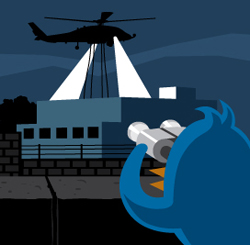This post originally appeared in our May issue of “Live Report from the Future of Marketing,” our monthly Post-Advertising newsletter. Subscribe for free here.
Perhaps the greatest part of the internet is how it allows complete strangers to come together around a singular event and create things both profound and absurd. The death of Osama bin Laden was just such a momentous occasion. While some took to the streets to celebrate, most went straight to their computers and mobile devices to let the world know how they felt. If Twitter’s record breaking 3,440 tweets per second (TPS) is any indication: people had a tremendous amount to say.
The Twitter comments on that Sunday night ranged from celebratory to humorous. One quick-thinking individual created the Twitter account @osamainhell which, in under 24 hours, obtained nearly 10,000 followers. But the twitterer who made the biggest impact was, of course, Sohaib Athar, the man now known as “The Guy Who Inadvertently Tweeted the bin Laden Raid.” Initially complaining about a low flying helicopter in his town of Abbottabad, Athar was unaware — as we all were —of the major event taking place a few blocks away from his house. As we now know, the helicopter was part of the Navy SEAL raid on bin Laden’s compound and the explosion Athar heard a few minutes later was the SEALS self-destructing another top-secret helicopter that had crashed during the incursion.
Elsewhere, Facebook users flocked to various “Osama is Dead” pages and added their “likes” while some contributed comments praising America’s military. Others, who were either too young or too ignorant to grasp the importance of Osama’s death went to Facebook to voice their confusion as to who the man actually was.
Aside from the sharing of thoughts and ideas, it was the collaboration on certain sites that gave others a unique voice and perspective on the matter. For example, once it was announced where Bin Laden was hiding, several people came up with the idea of supplying reviews to the compound. These faux reviews added a bit of humor to the news, taking the spin that they’d actually stayed there and were looking at it as a cement-walled hostel. As is typical of reviews on Yelp and Hotels.com, many tongue-in-cheek contributors were feigned shock at finding no ironing board or outrage that their Groupon was not accepted at the front desk.
Location-based apps such as FourSquare almost immediately began offering check-ins at various “locations” such as “Osama Bin Gonathon” or “Osamapocolypse.” Much like severe-weather related check-ins that spring up around blizzards and heat waves, these check-ins were a way to to get a digital record of saying “I was there. I lived through it.”
At it’s simplest form, these outlets are a way for people to feel connected to the world and collectively experience and react to historic events. Whether by humor or insight, these digital doorways allow individual voices to be heard. Everyone has an opportunity to be part of the first draft of history.





